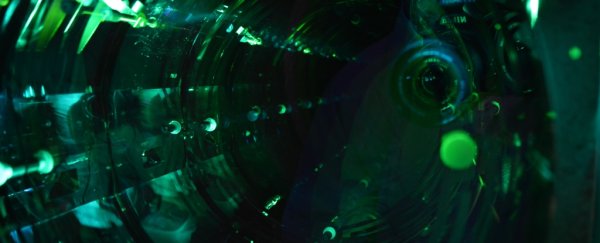Very rarely is anything completely still. All normal matter in the Universe is made of humming particles, minding their own business and vibrating at their own frequencies.
If we can get them to slow down as much as possible, the material enters what is known as the motional ground state. In this state, physicists can perform tests of quantum mechanics and quantum gravity, probing the boundary with classical physics to search for a way to unify the two.
Previously, this has been performed in the nanoscale; but now, for the first time, it's been done on a massive 'object' - the collective motions of the four mirrors of the LIGO gravitational wave interferometer, known as an optomechanical oscillator, with an effective mass of 10 kilograms (22 pounds).
The work represents a new way to probe the quantum realm.
"Nobody has ever observed how gravity acts on massive quantum states," said mechanical engineer Vivishek Sudhir of MIT.
"We've demonstrated how to prepare kilogram-scale objects in quantum states. This finally opens the door to an experimental study of how gravity might affect large quantum objects, something hitherto only dreamed of."
Achieving the quantum ground state of a cloud of atoms isn't easy. You need to cool the atom by applying just the right amount of force to stop its vibrations. If you don't cool it enough, it merely slows; so you need to know the exact energy level and direction of the atom's vibrations in order to apply the appropriate force to stop it.
This is called 'feedback cooling', and on the nanoscale it's simpler to do, because it's easier to isolate the smaller groups of atoms and minimize interference. The larger you go, though, the harder it becomes to handle that interference.
LIGO is one of the most precise instruments for measuring fine motion. It's designed to detect tiny ripples in space-time generated by collisions between massive objects up to billions of light-years away.
It consists of an L-shaped vacuum chamber, with laser lights beamed along its two 4-kilometer (2.5-mile) tunnels, and sent to a beam splitter to four mirrors, one at each end of each tunnel. When space-time ripples, the mirrors distort the light, producing an interference pattern that scientists can decode to determine the cause. And it's so sensitive that it can detect a change just one ten-thousandth the width of a proton, or 10-19 meters.
Each of LIGO's four 40-kilogram mirrors is suspended, and it's their collective motion that makes up the oscillator. The balance of the mirrors effectively reduces 160 kilograms of total weight to a single object of just 10 kilograms.
"LIGO is designed to measure the joint motion of the four 40-kilogram mirrors," Sudhir said. "It turns out you can map the joint motion of these masses mathematically, and think of them as the motion of a single 10-kilogram object."
By precisely measuring the motion of this oscillator, the team hoped to work out exactly the rate of feedback cooling required to induce the motional ground state… and then, obviously, apply it.
Unfortunately the very act of measuring throws a degree of randomness into the equation, making it difficult to predict the kinds of nudges needed to sap the energy out of the mirror's atoms.
To correct for this, the team cleverly studied each photon to estimate the activity of previous collisions, continuously building a more accurate map of how to apply the correct forces and achieve cooling.
Then, they applied the calculated force using electromagnets attached to the backs of the mirrors.
It worked. The oscillator stopped moving, almost completely. Its remaining energy was equivalent to a temperature of 77 nanokelvin (-273.15 degrees Celsius, or -459.67 degrees Fahrenheit).
Its motional ground state, 10 nanokelvin, is extremely close, especially considering the room temperature starting point. And 77 nanokelvin is also very close to the temperatures used in motional ground state studies on the nanoscale.
Moreover, it opens the door to some exciting possibilities. Macro-scale demonstrations and measurements of quantum phenomena - and maybe even applications for the same.
But quantum gravity is the big kicker. Kilogram-mass objects are more susceptible to gravity; the team's work raises hope to use this mass regime to study the quantum realm.
"Preparing something in the ground state is often the first step to putting it into exciting or exotic quantum states," said physicist Chris Whittle of MIT and the LIGO collaboration.
"So this work is exciting because it might let us study some of these other states, on a mass scale that's never been done before."
The research has been published in Science.
